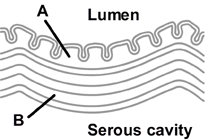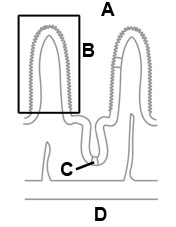IPHY 3410
Instructor: Dr. Leif Saul
Fall 2023

IPHY 3410Instructor: Dr. Leif Saul
|
 |
NOTE: these questions are intended for practice only. They do not reflect all major topics covered in the lectures.
1. Start in anatomical position, and then pronate the forearm completely. The thumb is now ____ to the palm of the hand.
A. Medial
B. Superior
C. Lateral
D. Inferior
E. Superficial
2. Which of the following muscles is primarily made up of a type of muscle tissue that has gap junctions?
A. External anal sphincter
B. A muscle that flexes your elbow
C. Oblique muscle layer of the stomach
D. Muscles of the pharynx
E. None of the above
3. Different syndesmoses differ in degree of movability primarily due to differences in the
A. amount of cartilage present in the joint
B. orientation of the fibers
C. depth of the socket
D. amount of tissue fluid present
E. length of the fibers
4. Which of the following is not present in all synovial joints?
A. Articular disc
B. Synovial fluid
C. Articular cartilage
D. Fibrous capsule
E. C and D.
5. The stomach
A. Has fewer muscle layers than the small intestine
B. Is essential for survival
C. Produces hormone(s) that travel through the blood
D. Is the main site of digestion in the body
E. Secretes acid and enzyme(s), both produced by the same cell type
6. Example(s) of structures with an immune function include(s):
A. Vermiform appendix
B. Peyer's patch
C. MALT
D. All of the above
E. None of the above
7. In a skeletal muscle, the entire structure that is wrapped by an endomysium is known as a
A. Cell
B. Myofibril
C. Muscle fiber
D. A and B
E. A and C
8. Depression is an example of
A.
Angular movement
B. Rotation
C. Movement around an axis
D. Inverted movement
E. None of the above
9. The metacarpophalangeal (knuckle) joints can perform movement around
A. no axes.
B. 1 axis.
C. 2 axes.
D. 3 axes.
E. 3 axes, or 4 axes if the person is double-jointed.
10. When a muscle contracts, what is happening on the microscopic level?
A. Each actin filament coils up to shorten
B. Each sarcomere stays the same length, but slides past other sarcomeres
C. Actin heads drag their way along a myosin filament
D. Satellite cells pull on muscle fibers
E. None of the above
11. In the anatomical position, abducting the forearm at the elbow
A. Occurs in the frontal plane
B. Occurs in the sagittal plane
C. Occurs in the transverse plane
D. Is not possible without damaging the joint
E. Is also known as pronation
12. The rotator cuff is an example of
A. A pivot joint
B. A ball-and-socket joint
C. Tendons that add stability to a joint
D. Ligaments that add stability to a joint
E. A modified joint
13. Place the following structures in correct order from proximal to distal:
(1) Jejunum, (2) duodenum, (3) sigmoid colon, (4) transverse colon, (5) ileocecal valve
A. (2) --> (1) --> (5) --> (3) --> (4)
B. (1) --> (2) --> (5) --> (4) --> (3)
C. (2) --> (1) --> (5) --> (4) --> (3)
D. (5) -->(2) --> (1) --> (4) --> (3)
E. (5) --> (1) --> (2) --> (3) --> (4)
14. In muscle anatomy, an antagonist means a
A. Muscle that opposes the action of another muscle
B. Fascicle that opposes the action of another fascicle
C. Protein that prevents excessive stretch of a muscle fiber
D. Nerve cell that inhibits contraction of a muscle fiber
E. Muscle that has major responsibility for a particular action
15. Rapid turnover of cells occurs in
A. Submucosa of the stomach
B. Mucosal epithelium of the small intestine
C. Epithelium of the serosa
D. Synovial membrane
E. Cardiac muscle tissue
16. You have a nightmare in which you are shrunk down to microscopic size and are standing on the epithelium of a mesentery, surrounded by the peritoneal cavity. Do you have any hope of escaping to the outside world? (You are not allowed to cross through any tissue layers.)
A. Yes, you just need to keep walking until you end up walking on the epithelium of the GI tract mucosa.
B. Yes, you just need to follow the blood vessels that travel through the mesentery.
C. Yes, you just need to find one of the intraperitoneal organs.
D. Yes, you just need to enter a gastric gland.
E. No.
17. Retroperitoneal organs such as the pancreas
A. Are suspended by mesenteries
B. Have adventitia
C. Have peritoneum
D. B and C
E. All of the above
18. The main, long-term effect of strength training is:
A. Each muscle fiber becomes thicker
B. Each muscle fiber becomes shorter
C. Each muscle fiber becomes longer
D. New muscle fibers are produced by cell division
E. New muscle fibers are formed from satellite cells
19. The sword pierced Octavius's belly, and the point of the sword ended up just reaching an olive in his stomach. Numerous layers of his body tissues and internal spaces were pierced in the process. Each of the following lists only some of these. Which of the following gives the layers or spaces in the correct order (from superficial to deep)?
A. Visceral peritoneum, peritoneal cavity, mesothelium
B. Mucosa, submucosa, lumen
C. Peritoneal cavity, visceral peritoneum, parietal peritoneum
D. Circular layer of muscularis externa, muscularis mucosae, lumen
E. Submucosa, mucosa, peritoneal cavity
20. Which form(s) of arthritis is/are (an) autoimmune condition(s)?
A. Gouty arthritis
B. Osteoarthritis
C. Rheumatoid arthritis
D. A and B
E. All of the above
21. If you accidentally swallow a sharp piece of bone that gets stuck in the wall of your large intestine, what will help you to dislodge it?
A. Fascia adherens
B. Muscularis mucosae
C. Oblique muscle layer
D. Mesentery
E. Intestinal crypt
22. What type(s) of muscle tissue can spontaneously contract under normal physiological conditions?
A. Smooth
B. Cardiac
C. Skeletal
D. A and B
E. All of the above
23. Carbohydrate digestion begins in the
A. Mouth
B. Stomach
C. Duodenum
D. Ileum
E. Large intestine
24. The mediastinum
A. Is restricted to the large intestine
B. Is where most of the esophagus is located
C. Is found only in infants and children
D. Functions primarily in the control of muscle contraction
E. None of the above
25. Where are new epithelial cells produced for the mucosa of the small intestine?
A. Intestinal crypts
B. Submucosa
C. Villi
D. Lacteals
E. Chyme
26.
Which of the following contain(s) synovial fluid?
A. Tendon sheath
B. Saddle joint
C. Plane joint
D. B and C
E. All of the above
27. The fibrous capsule of a ball-and-socket joint is made of:
A. elastic connective tissue.
B. reticular connective tissue.
C. dense regular connective tissue.
D. dense irregular connective tissue.
E. areolar connective tissue.
28. Which of the following actions involves moving the foot around the anterior-posterior axis?
A. Pronation
B. Eversion
C. Dorsiflexion
D. Elevation
E. Protraction
Questions 29-31 refer to the diagram at right showing the digestive tract wall. This wall consists of the following layers, which are all shown: circular muscle, epithelium of mucosa, lamina propria, longitudinal muscle, muscularis mucosae, serosa, submucosa. |
 |
29. Layer A is the
A. Submucosa
B. Muscularis mucosae
C. Lamina propria
D. Circular muscle
E. Longitudinal muscle
30. Layer B is the
A. Submucosa
B. Muscularis mucosae
C. Lamina propria
D. Circular muscle
E. Longitudinal muscle
31. Which of the following might be shown in the diagram?
A. Jejunum
B. Sigmoid colon
C. Stomach
D. Ileum
E. A or D
32. Components of skeletal muscle tissue include:
A. Motor unit
B. Endomysium
C. Blood vessel
D. B and C
E. None of the above
Questions 33 and 34 refer to the diagram at right. |
 |
33. The structure in box B is a ____ and the cell labeled C is a ____.
A. Villus; chief cell
B. Villus; stem cell
C. Plica circularis; goblet cell
D. Microvillus; enteroendocrine cell
E. Ruga; chief cell
34. Label A indicates the ____ and label D indicates the ____.
A. Peritoneal cavity; submucosa
B. Peritoneal cavity; circular muscle layer
C. Lumen; muscularis mucosae
D. Lumen; submucosa
E. None of the above
ANSWERS
1. A
2. C
3. E
4. A
5. C
6. D
7. E
8. E
9. C
10. E
11. D
12. C
13. C
14. A
15. B
16. E
17. D
18. A
19. D
20. C
21. B
22. D
23. A
24. B
25. A
26. E
27. D
28. B
29. C
30. E
31. B
32. E
33. B
34. D